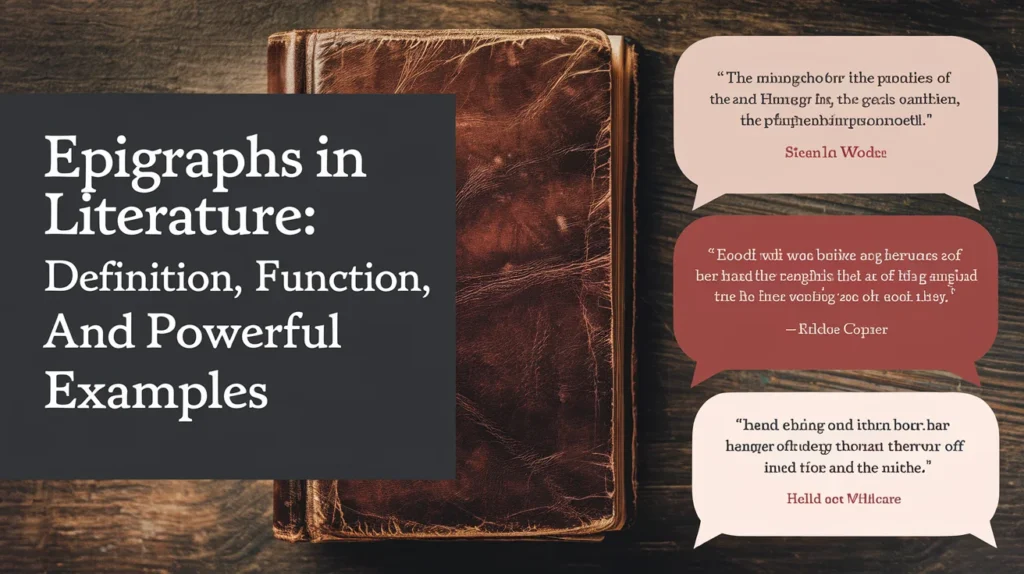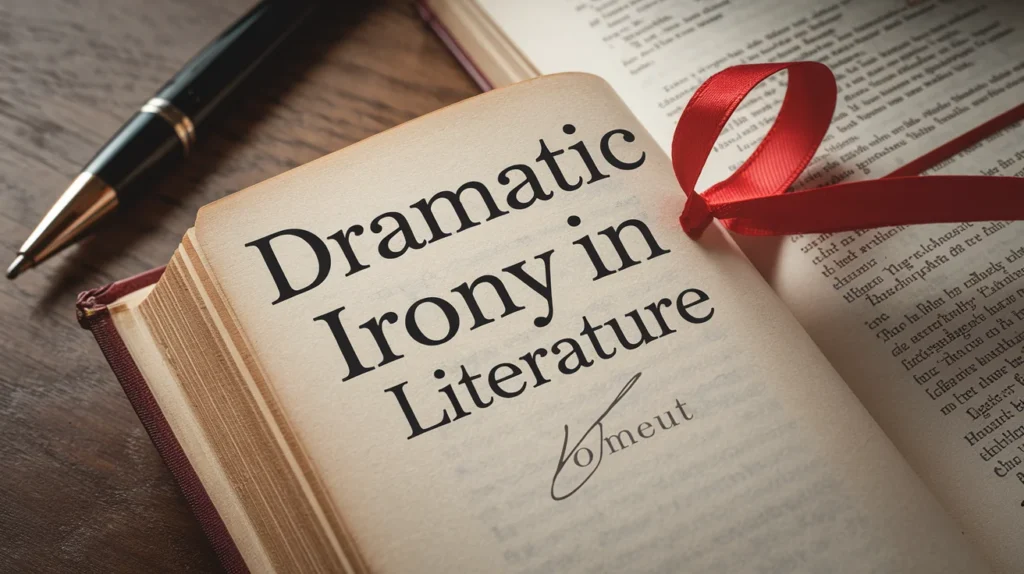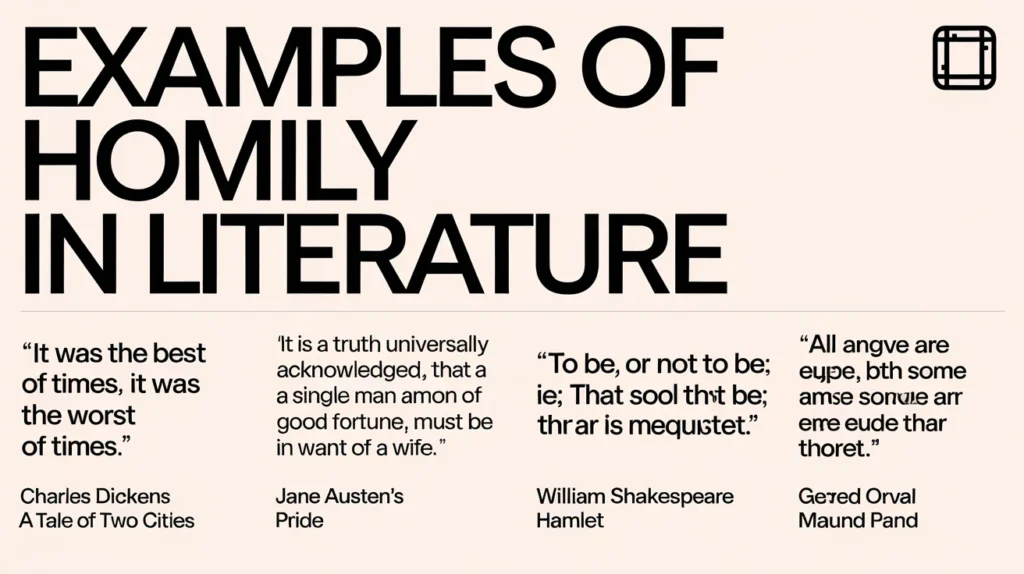The Hidden Power of Epigraphs
Ever flipped open a novel and stumbled upon a mysterious quote before Chapter 1? That’s an epigraph—a tiny literary gem packed with meaning. These short quotations, poems, or phrases aren’t just decorative; they’re strategic tools authors use to set the mood, hint at themes, or even mislead readers.
From F. Scott Fitzgerald to Margaret Atwood, great writers have used epigraphs to deepen their stories. But what makes them so effective? Why do some books feel incomplete without them? And how do they sneak into pop culture, like Breaking Bad or The Hunger Games?
In this guide, we’ll break down:
✔ What an epigraph really is (and how it’s different from an epitaph).
✔ Why authors use them—from foreshadowing to irony.
✔ 7 iconic examples from literature, dissected for hidden meanings.
✔ Epigraphs in movies and TV—because they’re not just for books.
✔ Related terms (so you’ll never confuse an epigraph with foreshadowing again).
Ready to decode these literary Easter eggs? Let’s dive in.
What Is an Epigraph? (And Why Should You Care?)
An epigraph is like a secret handshake between an author and reader—a short quote, phrase, or poem placed at the beginning of a book, chapter, or even a section. It’s not part of the main text, but it’s far from random. Think of it as a literary amuse-bouche—a tiny taste of what’s to come.
Epigraphs at a Glance
- Where you’ll find them: Before the first chapter, at the start of sections, or even before key scenes.
- What they look like: Usually italicized, indented, or set apart from the main text.
- Where they come from:
- Classic literature (Shakespeare, the Bible)
- Poetry (Emily Dickinson, Rumi)
- Philosophy (Nietzsche, Kierkegaard)
- Even fictional sources (like The Great Gatsby’s made-up poet)
Why Should You Care?
Because epigraphs aren’t just decoration—they’re strategic tools that:
✔ Set the mood (like a movie’s opening score).
✔ Hint at themes (without spoiling the plot).
✔ Add depth (by connecting the book to bigger ideas).
✔ Play mind games (sometimes they’re ironic or misleading).
Epigraph vs. Epitaph: Don’t Mix Them Up!
| Term | Definition | Example |
| Epigraph | A quote at a book’s start | “Call me Ishmael.” (Moby-Dick) |
| Epitaph | A tombstone inscription | “Here lies one whose name was writ in water.” (Keats’ grave) |
Fun Fact: Some authors write their own epigraphs (like Oscar Wilde in Dorian Gray), while others borrow from historical texts, songs, or even graffiti.
3 Reasons Authors Love Epigraphs
- They’re a Thematic Sneak Peek
- Example: 1984 opens with a fake quote about Big Brother, instantly signaling dystopian control.
- They Borrow Authority
- Quoting Shakespeare or the Bible makes a story feel weightier.
- They Create Mystery
- The Handmaid’s Tale uses a fake Quran verse—readers must ask: Why would Atwood invent this?
Case Study: To Kill a Mockingbird
- Epigraph: “Lawyers, I suppose, were children once.” (Charles Lamb)
- Why It Works:
- Foreshadows Scout’s loss of innocence.
- Undercuts adult hypocrisy (the town’s lawyers forget their childhood morals).
Your Turn: Next time you see an epigraph, pause and ask:
- Why did the author choose this?
- How does it connect to the story?
Epigraph vs. Epitaph: What’s the Difference?
| Term | Definition | Example |
| Epigraph | A quote at a book’s start | “Lawyers, I suppose, were children once.” (To Kill a Mockingbird) |
| Epitaph | An inscription on a tombstone | “Here lies one whose name was writ in water.” (John Keats’ grave) |
Fun Fact: Some authors, like T.S. Eliot, used epigraphs so often they became part of their signature style.
Why Do Authors Use Epigraphs? (5 Key Reasons)
Epigraphs aren’t just decoration—they’re strategic. Here’s why writers love them:
- Set the Mood
- A dark quote (“Hell is empty, and all the devils are here.”) primes readers for tragedy.
- A hopeful one (“The sun also rises.”) suggests renewal.
- Foreshadow Themes
- 1984 opens with a fictional quote about Big Brother, hinting at surveillance.
- Add Authority
- Quoting Shakespeare or the Bible lends weight to the story.
- Create Irony
- A cheerful epigraph before a grim tale (Catch-22) makes the darkness hit harder.
- Connect to Literary Tradition
- Moby-Dick’s epigraphs link it to classic mythology, elevating its themes.
Case Study: The Handmaid’s Tale uses a fake Quran verse to show how Gilead twists religion—a chilling preview of the regime’s lies.
7 Iconic Epigraph Examples in Literature (Explained)
1. The Great Gatsby – F. Scott Fitzgerald
- Epigraph: “Then wear the gold hat, if that will move her…” (From the fictional poet Thomas Parke D’Invilliers)
- Why It Works: Mirrors Gatsby’s illusion of wealth—he thinks money can win Daisy, but it’s all a performance.
2. The Bell Jar – Sylvia Plath
- Epigraph: The fig tree parable (from the Talmud) about a woman starving because she can’t choose which fig to eat).
- Why It Works: Symbolizes Esther’s paralysis—her fear of choosing a path destroys her.
3. The Picture of Dorian Gray – Oscar Wilde
- Epigraph: “The artist is the creator of beautiful things. To reveal art and conceal the artist is art’s aim.” (From Wilde’s own preface)
- Why It Works: This self-referential epigraph defends Wilde’s philosophy of “art for art’s sake.” It clashes brilliantly with the novel’s plot—where Dorian’s portrait conceals his sins while his face stays perfect, mocking the idea that art has no moral purpose.
Deep Dive: Wilde was trolling critics who called his work immoral. The epigraph dares readers to separate art from artist—while the story proves it’s impossible.
4. One Hundred Years of Solitude – Gabriel García Márquez
- Epigraph: “Many years later, as he faced the firing squad, Colonel Aureliano Buendía was to remember that distant afternoon when his father took him to discover ice.”
- Why It Works: This opening line (also the epigraph) drops us into magical realism’s time warp. It:
- Foreshadows the Colonel’s fate.
- Mixes past/future, a signature of Márquez’s style.
- Makes “ice” mystical—something ordinary made wondrous.
Fun Fact: The line was originally written for a different novel, but Márquez kept it because it “contained the whole book.”
5. The Handmaid’s Tale – Margaret Atwood
- Epigraphs:
- A fake Quran verse (“And when the great tree fell…”).
- A real Sufi proverb (“In the desert there is no sign that says, Thou shalt not eat stones.”).
- Why They Work: Atwood fakes Islamic scripture to show how Gilead twists religion to oppress women. The Sufi proverb hints at human nature—people don’t need rules to know certain acts (like rebellion) are necessary.
Real-World Parallel: Like real totalitarian regimes, Gilead cherry-picks texts to justify cruelty.
6. The Stranger – Albert Camus
- Epigraph: “Mother died today. Or maybe yesterday, I don’t know.”
- Why It Works: In just 10 words, it nails Meursault’s existential apathy. The indifference to time (today/yesterday) mirrors his detachment from morality.
Philosophy Bonus: This epigraph embodies absurdism—life has no inherent meaning, so why pretend?
7. Adventures of Huckleberry Finn – Mark Twain
- Epigraph: A satirical “notice” warning readers not to find “morals” or “plots” in the book.
- Why It Works: Twain mocks literary pretension while setting up his anti-authority tone. It’s a middle finger to critics who overanalyze—yet the book is deeply moral (it condemns racism).
Irony Alert: The “warning” makes you look harder for themes, proving Twain’s genius.
Epigraph Deep Cuts: 3 More You Should Know
- Invisible Man (Ralph Ellison) – Quotes T.S. Eliot and the Bible to frame the protagonist’s identity crisis.
- Frankenstein (Mary Shelley) – Uses Paradise Lost (“Did I request thee, Maker, from my clay?”) to compare Frankenstein to God.
- The Sun Also Rises (Hemingway) – Quotes Ecclesiastes (“The sun also ariseth…”) to echo postwar disillusionment.
Pro Tip: Spot an epigraph from classic literature or the Bible? It’s usually a theme cheat code.
Why These Epigraphs Stick With Us
- They’re puzzles—the best ones reward rereading.
- They frame the story like a painting’s border.
- They whisper secrets the author couldn’t say outright.
Your Turn: Next time you see an epigraph, play detective. What’s it hiding?
Tables & Lists for Clarity
Epigraphs by Function
| Type | Example | Effect |
| Foreshadowing | 1984’s Big Brother quote | Dread |
| Irony | Catch-22’s cheerful war quote | Dark humor |
| Authority | Moby-Dick’s mythology quotes | Grandeur |
Books That Use Fake Epigraphs
- The Great Gatsby (fictional poet)
- The Handmaid’s Tale (fake Quran verse)
- House of Leaves (fake academic citations)
Epigraphs in Pop Culture (Beyond Books)
Epigraphs aren’t just for novels—they appear in TV, movies, and even video games:
- Breaking Bad: The episode “I.F.T.” opens with Walt Whitman’s poetry, foreshadowing Walter White’s ego.
- The Hunger Games: The “I volunteer as tribute!” line becomes a recurring motif of sacrifice.
Why It Matters: These borrowed words add depth, just like in literature.
Related Terms (Epigraph vs. Foreshadowing vs. Epitaph)
- Foreshadowing: Hints at future events (“Beware the Ides of March.”)
- Epitaph: A tombstone inscription (“Rest in peace.”)
Final Thoughts: Why Epigraphs Matter
Epigraphs are miniature keys to a story’s deeper meaning. Next time you see one, pause and think: Why did the author choose this? You might uncover hidden layers.
Want more literary deep dives? Subscribe for breakdowns like this every week!
FAQs About Epigraphs
1. Can an epigraph be a song lyric?
Yes! Stephen King used lyrics from Metallica in The Dark Tower series.
2. Do all books need an epigraph?
No—but the best ones use them purposefully, not just for decoration.
3. Who decides the epigraph?
Usually the author, but sometimes editors suggest them.


